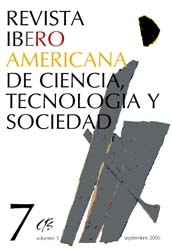Movilidad de estudiantes universitarios e internacionalización de la educación superior
DOI:
https://doi.org/10.52712/issn.1850-0013-969Palabras clave:
migraciones, educación superior, ciencia e ingenieríaResumen
El presente trabajo analiza diversos aspectos de los fenómenos de movilidad internacional de estudiantes universitarios. Tales procesos constituyen una de las principales manifestaciones de la movilidad de personal calificado y son, asimismo, la faceta más notoria de la internacionalización de la educación superior. Se analizan aquí las principales dimensiones globales de la movilidad internacional de estudiantes universitarios, especialmente de aquellos que realizan estudios de posgrado en ciencias e ingeniería en el extranjero, y se presentan datos estadísticos de estudios recientes en esta materia.
Descargas
Citas
A LTBACH, Philip (2003): “Foreign Study: Changing Patterns and Competitive Challenges”, International Higher Education, Nº 30, Winter.
AUSTRALIAN GOVERNMENT (2005): Australia’s Competitors in International Education: July 2005 Update, Department of Education, Science and Training.
BHAGWATI, Jagdish y RAO, Milind (1996): “Foreign Students in Science and Engineering Ph.D. Programs: an Alien Invasion or Brain Gain?”, en Lowell, B. Lindsay (ed.): Temporary Migrants in the United States, Washington, U.S. Commision on Immigration Reform.
BÖHM, A. et al. (2003): Global Student Mobility 2025: Analysis of Global Competition and Market Share, IDP, Sydney.
DOUGLASS, John A. (2006): “The Waning of America’s Higher Education Advantage: International Competitors Are No Longer Number Two and Have Big Plans in the Global Economy”, Center for Studies in Higher Education, UC Berkeley, Paper CSHE-9-06, en http://repositories.cdlib.org/cshe/CSHE-9-06
FINN, Michael G. (2003): Stay Rates of Foreign Doctorate Recipients from U.S. Universities, 2001, Science and Engineering Education Program, Oak Ridge Institute for Science and Education, November.
FINNIE, Ross (ed.) (2001): “The Brain Drain: Myth and Reality. What It Is and What Should be Done”, Choices, IRPP, noviembre.
FREEMAN, Richard B. (2005): “Does Globalization of the Scientific/Engineering Workforce Threaten U.S. Economic Leadership?”, NBER Working Paper No. 11457.
GEDRA, Surendra, LARYEA, Samuel y SONGSAKUL, Thitima (2004): “International Mobility of Skilled Labour: Analytical and Empirical Issues, and Research Priorities”, Ottawa, Skills Research Initiative Working Paper Series, Working Paper 2004 D-01.
GOLDEN, Daniel (2002): “Foreign Students’ High Tuition Spurs Pager Junior Colleges to Fudge Facts”, International Higher Education, Nº 29, Fall (Originalmente publicado en el Wall Street Journal).
GUPTA, D., M. NERAD, y J. CERNY (2003): “International Ph.D.s: Exploring the decision to stay or return”, International Higher Education, 31 (Spring).
HIGHER EDUCATION FUNDING COUNCIL FOR ENGLAND (2004): International student mobility, report by the Sussex Centre for Migration Research, University of Sussex, and the Centre for Applied Population Research, University of Dundee, www.hefce.ac.uk/pubs/hefce/2004/04i_30/04_30.pdf
K N I G H T, Jane (2005): “New Typologies for Crossborder Higher Education”, International Higher Education.
NATIONAL SCIENCE FOUNDATION (2004): Graduate Students and Postdoctorates in Science and Engineering 2002, Arlington, VA, National Science Foundation.
NATIONAL SCIENCE FOUNDATION, NATIONAL INSTITUTES OF HEALTH, U.S. DEPARTMENT OF EDUCATION, NATIONALENDOWMENT FOR THE HUMANITIES, U.S. DEPARTMENT OF AGRICULTURE y NATIONAL AERONAUTICS AND SPACE ADMINISTRATION (2004): Doctorate Recipients from United States Universities: Summary Report 2003, Chicago, NORC at the University of Chicago.
OECD (2004a): Internationalisation and Trade in Higher Education. Opportunities and Challenges, París, OECD.
OECD (2004b): Learning for Tomorrow’s World: First Results from PISA 2003, París, OECD.
PRICEWATERHOUSE COOPERS (2002): Managing mobility matters - a European perspective, PriceWaterhouseCoopers.
RITZEN, J.M.M. (2006): “Scenarios for Higher Education, 2020 or When Will China Invade Iran?”, Keynote address at OECD Ministerial Meeting, June 27th, Athens, Greece.
TEITELBAUM, Michael (2003): “The U.S. Science and Engineering Workforce: An Unconventional Portrait”, en Pan-Organizational Summit on the U.S. Science and Engineering Workforce: Meeting Summary, Washington, National Academies Press.
THE NATIONAL ACADEMIES (2005): Policy Implications of International Graduate Students and Postdoctoral Scholars in the United States, Washington, D.C., The National Academies Press.
TODD, Emanuel (1998): La ilusión económica. Ensayo sobre el estancamiento de las sociedades desarrolladas, Madrid, Taurus.
VINCENT-LANCRIN, Stéphan (2004): “Building Capacity through Cross-border Tertiary Education”, paper prepared for the Unesco/OECD Australia Forum on Trade in Educational Services, 11-12 October 2004, Sydney, A u s t r a l i a , http://www.oecd.org/dataoecd/43/25/33784331.pdf
WAGNER, Anne-Catherine (1998): Les nouvelles élites de la mondialisation. Une immigration dorée en France, París, PUF.
WYCOFF, Andrew y SCHAAPER, Martin (2005): “The changing dynamics of the global market for the highly-skilled”, paper presentado a la Advancing Knowledge and the Knowledge-Economy Conference, National Academy of Science, Washington. D.C., January 2005.
Descargas
Publicado
Cómo citar
Número
Sección
Licencia
Derechos de autor 2025 CC Attribution 4.0

Esta obra está bajo una licencia internacional Creative Commons Atribución 4.0.
Todos los números de CTS y sus artículos individuales están bajo una licencia CC-BY.
Desde 2007, CTS proporciona un acceso libre, abierto y gratuito a todos sus contenidos, incluidos el archivo completo de su edición cuatrimestral y los diferentes productos presentados en su plataforma electrónica. Esta decisión se sustenta en la creencia de que ofrecer un acceso libre a los materiales publicados ayuda a un mayor y mejor intercambio del conocimiento.
A su vez, para el caso de su edición cuatrimestral, la revista permite a los repositorios institucionales y temáticos, así como también a las web personales, el auto-archivo de los artículos en su versión post-print o versión editorial, inmediatamente después de la publicación de la versión definitiva de cada número y bajo la condición de que se incorpore al auto-archivo un enlace a la fuente original.











